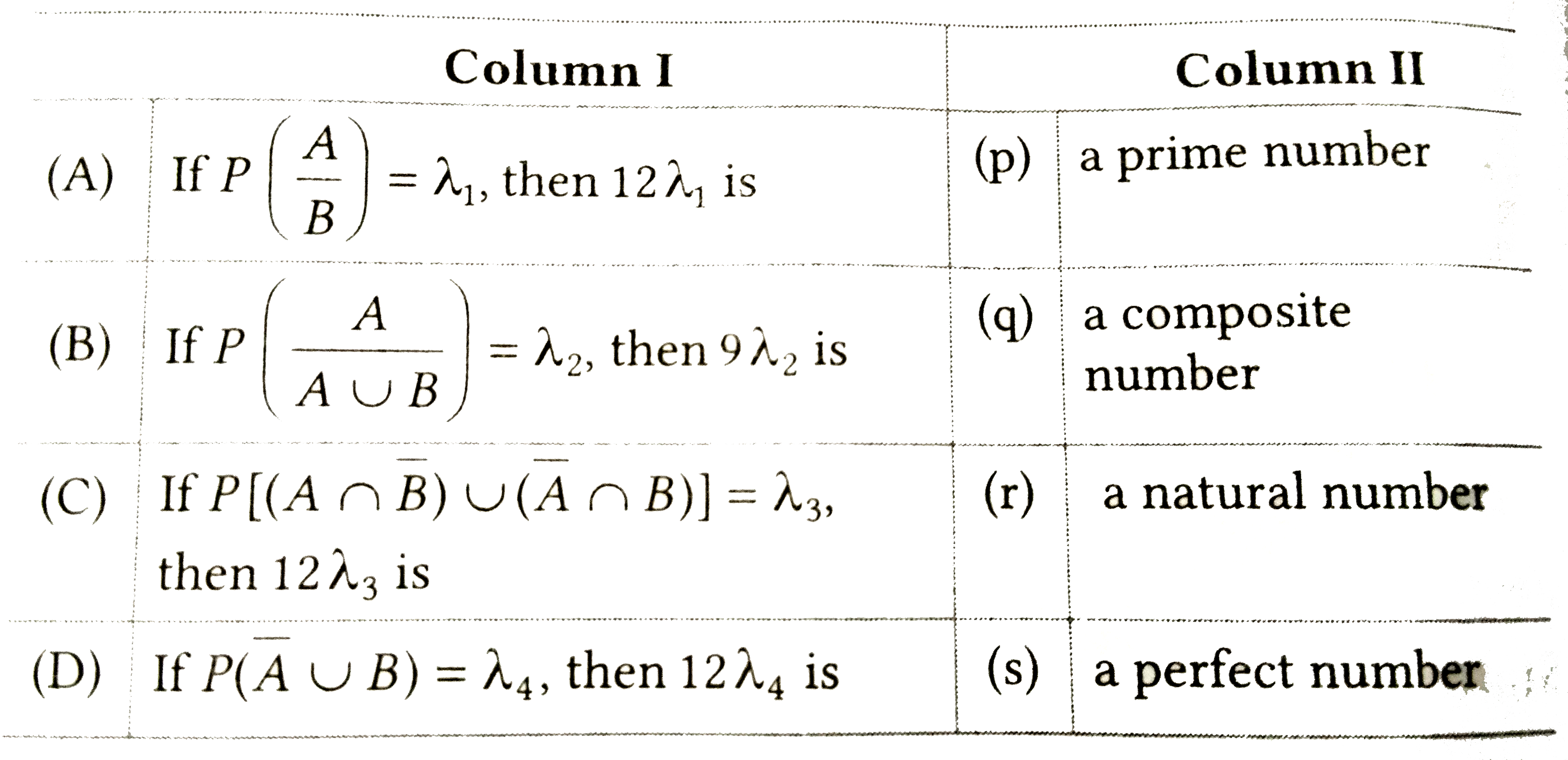Let A and B be two events such that P¯¯¯¯¯¯¯¯¯¯¯¯¯(A∪B)=16,P(A∩B)=14andP¯¯¯A=14,where ¯¯¯A stands for complement of event A. then , events A and B are
independent but not equally likely
mutually exculusive and independent
equally likely and mutually exclusive
equally likely but not independent
The correct Answer is:A
To solve the problem step by step, we will use the provided probabilities and the definitions of union, intersection, and complements of events.
Step 1: Identify the given probabilities
We are given:
- P(¯¯¯¯¯¯¯¯¯¯¯¯¯¯A∪B)=16
- P(A∩B)=14
- P(¯¯¯¯A)=14
Step 2: Calculate P(A)
Since P(¯¯¯¯A)=14, we can find P(A) using the complement rule:
P(A)=1−P(¯¯¯¯A)=1−14=34
Step 3: Calculate P(A∪B)
Using the complement rule, we can find P(A∪B):
P(A∪B)=1−P(¯¯¯¯¯¯¯¯¯¯¯¯¯¯A∪B)=1−16=56
Step 4: Use the formula for P(A∪B)
The formula for the probability of the union of two events is:
P(A∪B)=P(A)+P(B)−P(A∩B)
Substituting the known values:
56=P(A)+P(B)−P(A∩B)
56=34+P(B)−14
Step 5: Simplify the equation
Now, we simplify the equation:
56=34+P(B)−14
56=34−14+P(B)
56=24+P(B)
56=12+P(B)
Step 6: Solve for P(B)
Now, we solve for P(B):
P(B)=56−12
To subtract, convert 12 to sixths:
12=36
Thus,
P(B)=56−36=26=13
Step 7: Check for independence
To check if events A and B are independent, we need to verify if:
P(A∩B)=P(A)⋅P(B)
Substituting the values:
P(A∩B)=14,P(A)=34,P(B)=13
Calculating P(A)⋅P(B):
P(A)⋅P(B)=34⋅13=312=14
Since P(A∩B)=P(A)⋅P(B), events A and B are independent.
Conclusion
Since A and B are independent but not equally likely (as P(A)=34 and P(B)=13), the final answer is:
Events A and B are independent but not equally likely.
---
- P(¯¯¯¯¯¯¯¯¯¯¯¯¯¯A∪B)=16
- P(A∩B)=14
- P(¯¯¯¯A)=14
P(A)=1−P(¯¯¯¯A)=1−14=34
P(A∪B)=1−P(¯¯¯¯¯¯¯¯¯¯¯¯¯¯A∪B)=1−16=56
P(A∪B)=P(A)+P(B)−P(A∩B)
Substituting the known values:
56=P(A)+P(B)−P(A∩B)
56=34+P(B)−14
56=34+P(B)−14
56=34−14+P(B)
56=24+P(B)
56=12+P(B)
P(B)=56−12
To subtract, convert 12 to sixths:
12=36
Thus,
P(B)=56−36=26=13
P(A∩B)=P(A)⋅P(B)
Substituting the values:
P(A∩B)=14,P(A)=34,P(B)=13
Calculating P(A)⋅P(B):
P(A)⋅P(B)=34⋅13=312=14
Since P(A∩B)=P(A)⋅P(B), events A and B are independent.
Topper's Solved these Questions
- PROBABILITYBOOK - ARIHANT MATHS ENGLISHCHAPTER - PROBABILITYEXERCISE - Exercise (Subjective Type Questions)
15 Videos
- PERMUTATIONS AND COMBINATIONS BOOK - ARIHANT MATHS ENGLISHCHAPTER - PERMUTATIONS AND COMBINATIONS EXERCISE - Exercise (Questions Asked In Previous 13 Years Exam)
28 Videos
- PRODUCT OF VECTORSBOOK - ARIHANT MATHS ENGLISHCHAPTER - PRODUCT OF VECTORSEXERCISE - Exercise (Questions Asked In Previous 13 Years Exam)
51 Videos
Similar Questions
A and B are two events such that P(A∪B)=34,P(A)=13,P(¯¯¯A∩B)=
View SolutionLet A and B be two events such that p(¯¯¯¯¯¯¯¯¯¯A∪B)=16,p(A∩B)=14 and p(¯¯¯A)=14 , where ¯¯¯A stands for the complement of the event A. Then the events A and B are (1) mutually exclusive and independent (2) equally likely but not independent (3) independent but not equally likely (4) independent and equally likely
View Solution
Knowledge Check
If A and B be two events such that P(A)=12P(B)=13andP(AB)=14 thenP(A∩B) equals
A112B34C14D316
If A and B are two events such that P(A∪B)=56,P(A)=13andP(B)=34, then A and B are
View SolutionIf A and B are two independent events, such that P(A)=13andP(B)=14.

View SolutionA and B are two independent events such that P(A)=15,P(A∪B)=710. Then ,P(¯¯¯B)=
View SolutionLet A and B be two events such that p(¯¯¯A∪B)=16,p(A∩B)=14 and p(¯¯¯A)=14 , where ¯¯¯A stands for the complement of the event A. Then the (1) mutually exclusive and independent (2) equally likely but not independent (3) independent but not equally likely (4) independent and equally likely
View SolutionIf A and B are two events such that P(A)=14,P(B)=12andP(A∩B)=18, then P ( not A and not B) =
View SolutionIf A and B are two events such that P(A)=14,P(B)=12andP(A∩B)=18. Then, find P (not A and not B).
View SolutionIf A and B are events such that P(A'∪B')=34,P(A'∩B')=14 and P(A)=13, then find the value of P(A'∩B)
View Solution
